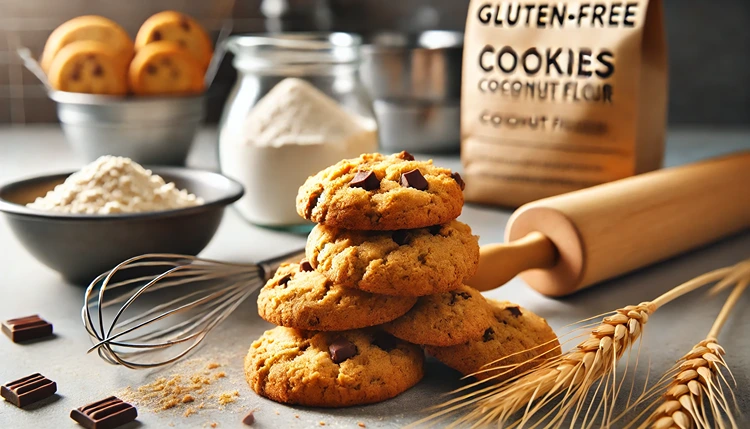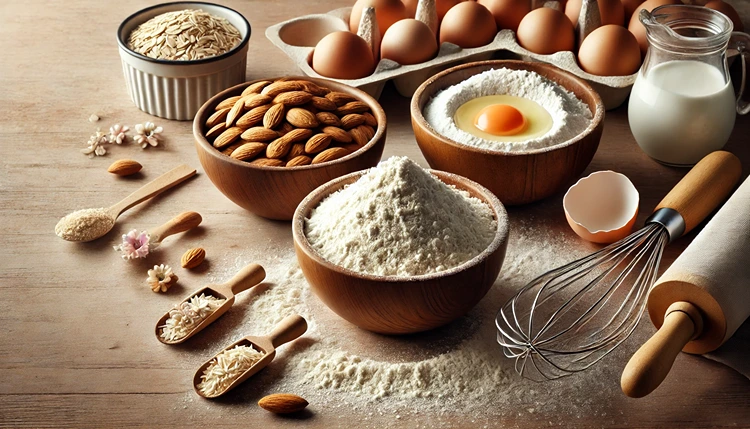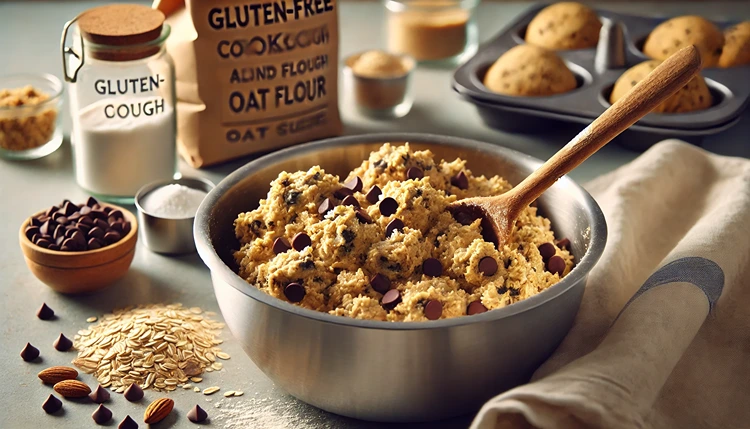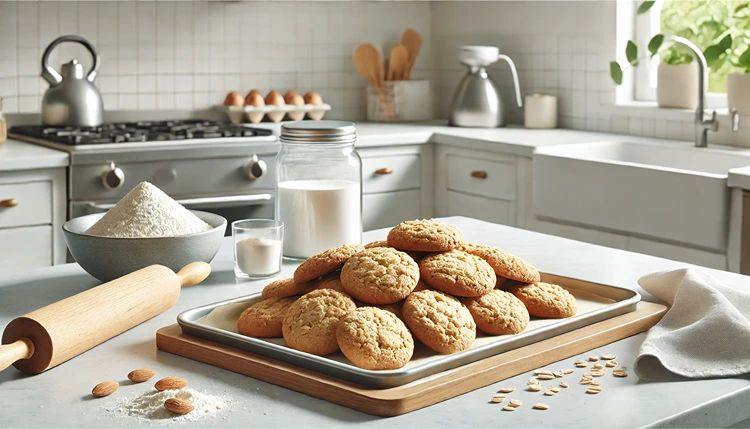There’s something magical about the smell of freshly baked cookies filling the kitchen. For those on a gluten-free journey, though, nailing the perfect cookie can sometimes feel like trying to hit a moving target. The world of gluten-free baking flours is vast, and each one behaves a little differently. So, how do you pick the right flour for the perfect batch of cookies? Let’s take a closer look at some of the top gluten-free baking flours and how they can help you create cookies that are soft, chewy, and packed with flavor.
Why Is Choosing the Right Gluten-Free Flour Important?
The absence of gluten in gluten-free flours changes the way baked goods come together. Gluten provides structure and elasticity, which is why traditional cookies often have that perfect balance between soft and chewy. In gluten-free baking, we have to get a bit creative with flour blends and other ingredients to achieve similar results. Understanding what different gluten-free flours offer can help you make better choices for your cookie recipes, ensuring you get the texture, flavor, and structure you’re craving.
Helpful Hint:
For the best results in gluten-free baking, consider using a combination of flours rather than just one. This helps to mimic the texture that gluten would normally provide.
What’s the Deal with Almond Flour?
Almond flour is one of the most popular choices for gluten-free cookies, and for good reason. It’s made from finely ground blanched almonds and has a natural sweetness that pairs perfectly with cookies. But almond flour can be tricky. Since it lacks the structure that gluten provides, cookies made with almond flour can be a bit more delicate, often with a chewy, almost melt-in-your-mouth texture.
Here’s what you can expect when baking with almond flour:
- Rich, nutty flavor that complements most cookie recipes.
- Moist and soft texture, great for chewy cookies.
- A good source of protein and healthy fats, making your cookies a bit more nutritious.
- Because it absorbs less moisture, almond flour can lead to cookies that are softer and spread more than expected.
Best Uses for Almond Flour in Cookies

Almond flour works best in cookie recipes where a soft texture is desired. Think classic chocolate chip cookies or delicate shortbread. It’s also fantastic in recipes that call for some sort of binding agent, like eggs or nut butter, which help to hold the cookies together.
Helpful Hint:
If your cookie dough feels a bit too soft when using almond flour, try chilling it before baking to prevent the cookies from spreading too much.
How Does Coconut Flour Affect Cookie Texture?
Coconut flour is another popular gluten-free flour, but it behaves very differently from almond flour. Made from ground, dried coconut meat, coconut flour is incredibly absorbent. You only need a small amount in comparison to other flours, which can be a bit of an adjustment if you’re new to gluten-free baking.
Cookies made with coconut flour tend to be more dense and crumbly, with a slightly grainy texture. However, the natural sweetness of coconut flour makes it a great option for certain types of cookies.
Best Uses for Coconut Flour in Cookies
Coconut flour shines in recipes where you want a denser cookie, like peanut butter cookies or shortbread-style cookies. Because of its absorbent nature, coconut flour can sometimes make cookies feel a bit dry, so it’s essential to add enough moisture to the dough, whether that’s through eggs, butter, or a vegan alternative.
Helpful Hint:
When using coconut flour, try increasing the liquid in your recipe to balance out the absorbent nature of the flour. This can help prevent cookies from turning out too dry or crumbly.
What About Rice Flour in Cookies?
Rice flour is one of the most commonly used gluten-free flours because it’s versatile, affordable, and has a neutral taste. There are two main types of rice flour: white rice flour and brown rice flour. Both can be used in cookie recipes, but they offer slightly different results.
Here’s a quick breakdown of the two:
- White rice flour: Light and neutral, it adds crispness to cookies but may lead to a slightly gritty texture.
- Brown rice flour: Heavier and more fibrous, it has a slightly nutty flavor and adds a bit more structure.
Best Uses for Rice Flour in Cookies
Rice flour is best when used as part of a gluten-free flour blend, rather than on its own. It works well in crisp cookies like gingersnaps or sugar cookies where a bit of crispness is a good thing. However, for softer cookies, you’ll want to combine it with another flour like almond or oat flour to prevent that gritty texture from coming through.
How Does Oat Flour Perform in Cookie Baking?

Oat flour is a great option for gluten-free cookies if you’re looking for something with a mild, slightly sweet flavor and a bit more fiber. Made from ground oats, oat flour adds a chewiness to cookies that many people love. It’s also relatively easy to make at home by grinding gluten-free oats in a food processor.
Because of its fine texture, oat flour helps bind ingredients together, which makes it a great choice for chewy cookies. It doesn’t have the same absorbency as coconut flour, but it does hold moisture well, which is ideal for creating a soft texture.
Best Uses for Oat Flour in Cookies
Oat flour is ideal for cookies that are meant to be chewy and soft, like oatmeal cookies or chocolate chip cookies. It’s also great for adding a bit of fiber to your baked goods, making them a little more filling without sacrificing flavor or texture.
How Does Tapioca Flour Contribute to Cookie Texture?

Tapioca flour, also known as tapioca starch, is derived from the root of the cassava plant and is a versatile gluten-free option that works well in a variety of baked goods. In cookies, tapioca flour helps improve texture by adding chewiness and elasticity, which can sometimes be missing in gluten-free recipes. It’s often used as part of a gluten-free flour blend to give cookies that desirable chew without being too dense or gritty.
One of the key benefits of tapioca flour is its ability to bind ingredients together, providing structure and helping cookies hold their shape. It also helps give cookies a slightly crispy exterior, while keeping the inside soft and chewy.
Best Uses for Tapioca Flour in Cookies
While tapioca flour isn’t usually used as the main flour in cookies, it works wonders when combined with other gluten-free flours. For example, pairing tapioca flour with almond or rice flour can yield cookies that have a balanced texture—crispy on the outside and chewy on the inside. It’s a great addition to gluten-free chocolate chip cookies or even snickerdoodles, where chewiness is essential.
Comparison of Gluten-Free Flours for Cookies
| Flour | Best For | Texture | Special Notes |
|---|---|---|---|
| Almond Flour | Chewy Cookies | Soft, Moist | Works well with nut-based recipes; high in fat |
| Coconut Flour | Dense Cookies | Crumbly, Dry | Requires extra moisture due to high absorbency |
| Rice Flour | Crisp Cookies | Light, Slightly Gritty | Best used in blends to reduce grittiness |
| Oat Flour | Soft, Chewy Cookies | Smooth, Mild | Great for oatmeal-based recipes; adds fiber |
| Tapioca Flour | Chewy Cookies | Elastic, Slightly Crispy | Best used in combination with other flours |
Is Sorghum Flour Good for Gluten-Free Cookies?
Sorghum flour is made from an ancient grain that’s naturally gluten-free and has a mild, slightly sweet flavor. It’s becoming more popular in gluten-free baking because of its versatility and nutritional profile, as it’s high in fiber and protein. However, because sorghum flour can be a bit dense, it’s best used in combination with other gluten-free flours to create the perfect cookie texture.
In cookies, sorghum flour adds a bit of structure and a mild flavor that complements both sweet and savory ingredients. It doesn’t have the same binding power as tapioca flour or the chewiness of oat flour, but it’s a good option if you’re looking for a flour with a neutral flavor and slightly more substance.
Best Uses for Sorghum Flour in Cookies
Sorghum flour works best when mixed with other flours like almond, rice, or tapioca to create a balanced cookie. It’s especially useful in cookie recipes that require a bit more density, such as molasses cookies or gingerbread cookies. Its subtle sweetness makes it a good option for spiced cookies or those that are flavored with fruits or nuts.
Are Gluten-Free All-Purpose Flour Blends Worth Using?
When it comes to simplicity, many bakers turn to gluten-free all-purpose flour blends as a one-stop solution for baking. These pre-made blends are designed to mimic traditional all-purpose flour as closely as possible, combining a mix of gluten-free flours like rice, tapioca, and sorghum, along with binding agents like xanthan gum to provide elasticity.
The benefit of using an all-purpose blend is that it saves time and takes the guesswork out of figuring out which flours to use. Most blends are created to provide a well-rounded texture, making them suitable for a wide range of cookie recipes. However, not all gluten-free blends are created equal, so it’s important to check the ingredients and reviews to find one that works for your baking needs.
Best Uses for Gluten-Free All-Purpose Flour Blends in Cookies
All-purpose gluten-free blends are great for when you want a simple, straightforward option that doesn’t require mixing several different types of flours. They’re ideal for standard cookie recipes like chocolate chip, oatmeal raisin, and sugar cookies. However, depending on the blend, you might still need to add additional binders or moisture, such as eggs or xanthan gum, to get the desired texture.
Helpful Hint:
When using a gluten-free all-purpose blend, try to use one that includes a binding agent like xanthan gum. If your blend doesn’t have one, you might need to add it separately to achieve a texture that holds together well.
Which Flour Is Best for Achieving a Crispy Cookie?
For those who prefer their cookies with a crisp edge and a slightly crunchy bite, the type of flour you use can make all the difference. Rice flour is one of the best options for creating a crispy texture, especially when used in a blend. Its lightness and slightly gritty texture help cookies bake up crisp, which is perfect for recipes like shortbread or gingersnaps.
Another flour to consider is tapioca flour, which can help give cookies a crisp exterior while maintaining chewiness inside. A small amount of tapioca flour mixed with other flours like almond or rice can help achieve that perfect balance.
Which Flour Is Best for a Chewy Cookie?
When it comes to chewy cookies, you’ll want to choose a flour that can hold onto moisture and provide some elasticity. Almond flour and oat flour are two of the best options for creating chewy cookies. Almond flour’s natural fat content helps keep cookies moist, while oat flour adds just enough structure to give cookies a chewy bite without being too dense.
Combining these flours with a starch like tapioca flour can also help. Tapioca adds chewiness and helps bind the ingredients together, which is essential in gluten-free cookies where there’s no gluten to hold things in place.
How to Adjust Liquid Ingredients for Different Gluten-Free Flours?
Because gluten-free flours absorb liquids differently, it’s important to adjust your liquid ingredients accordingly when making cookies. For example, flours like coconut flour are extremely absorbent and will require more liquid to prevent your cookies from turning out too dry. On the other hand, flours like almond flour don’t absorb as much moisture, so you might not need to add as much liquid.
A good rule of thumb is to start by following the recipe, then adjust based on the texture of your dough. If it feels too wet, you can add a little more flour, and if it’s too dry, add a splash of milk or another liquid.
How to Choose the Best Gluten-Free Flour for Your Cookie Recipe
Ultimately, the best gluten-free flour for your cookies depends on the type of cookie you’re aiming for. If you want a chewy, soft cookie, flours like almond or oat flour will be your best bet. If you’re after a crispy, crunchy cookie, rice flour or a blend with tapioca can help achieve that. And if you’re looking for a one-size-fits-all solution, an all-purpose gluten-free flour blend can make things easier.
It’s also worth experimenting with different combinations of flours to find the perfect mix for your baking style. Many gluten-free bakers find that using a blend of flours rather than relying on just one yields the best results. With some trial and error, you’ll be able to perfect your gluten-free cookie recipes and enjoy delicious cookies every time!
Weighing the Pros and Cons
Pros
- Wide variety of gluten-free flour options for different cookie textures.
- Almond flour provides a natural sweetness and healthy fats for a richer cookie.
- Oat flour adds fiber, making cookies more nutritious.
- Gluten-free blends simplify the baking process by mimicking traditional flour.
- Tapioca flour enhances chewiness and elasticity in gluten-free cookies.
- Coconut flour works well in dense cookie recipes, adding subtle flavor.
Cons
- Some flours like coconut and almond flour require more moisture adjustments.
- Rice flour can lead to gritty or crumbly textures if not blended with other flours.
- Certain flours like coconut can absorb too much liquid, resulting in dry cookies.
- Finding the right flour combination can require trial and error in recipes.
- Gluten-free all-purpose blends vary in quality and may need additional binders.
- Costs for gluten-free flours can be higher than regular wheat flour.
Frequently Asked Questions
Wrapping Up
Creating the perfect gluten-free cookie takes some experimentation, but understanding the unique properties of different gluten-free flours makes it easier. From almond flour’s rich, chewy texture to the absorbent nature of coconut flour, each flour plays a role in achieving your desired result. Mixing flours, adjusting moisture levels, and adding binding agents like xanthan gum can help ensure your cookies come out just right. Whether you’re craving chewy chocolate chip cookies or crisp shortbread, choosing the right flour will make all the difference in your gluten-free baking adventures.

